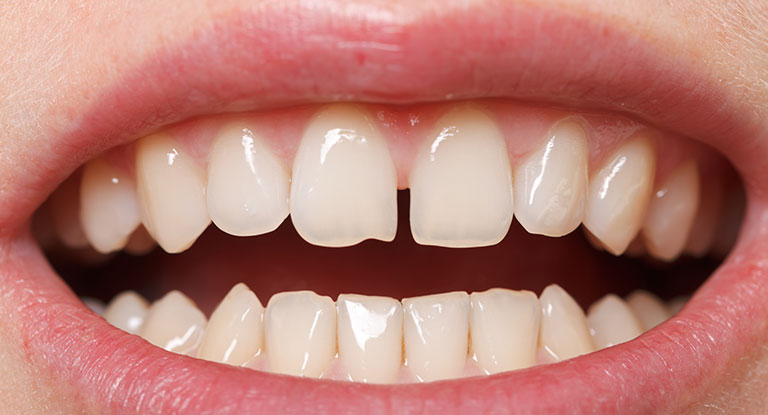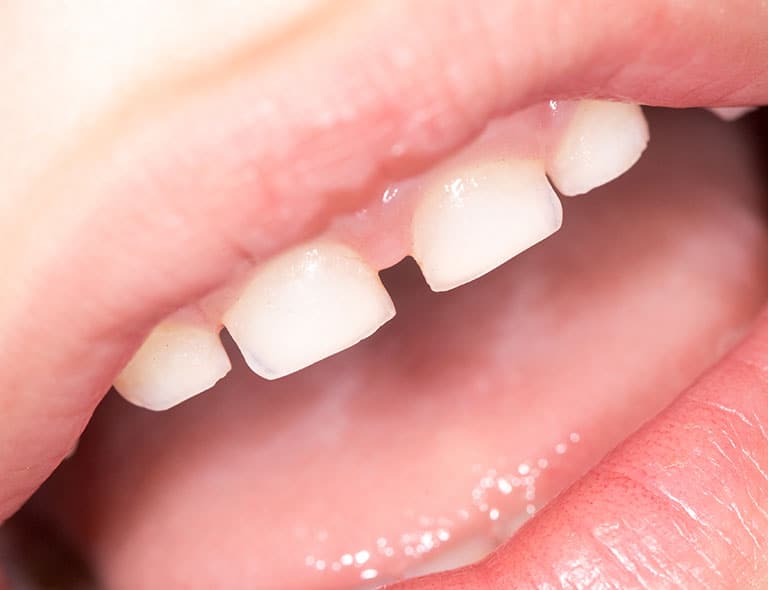

Diastema is the gap between two teeth. This is very common in children when the milk teeth emerge, but the spaces disappear as permanent teeth erupt.
If you have several gaps between your teeth after the development of your permanent teeth, you may decide to consider other malocclusion treatment options. Some people may keep their gap teeth, especially between the two front teeth. Some believe that their front gap teeth enhance their beauty.
You have a lot to know about diastema. We have provided all information on diastema, its causes, and how it can be corrected; you should read further to find out more.

Diastema is simply defined as the gap between two teeth. The gap between teeth can happen anywhere in the mouth, but it is most noticeable when it is between the two front teeth. When it occurs in the lower teeth, it is referred to as mandibular diastema while a gap in the two teeth at the front is called a midline or median diastema.
Researches have shown that between 1.6% to 25.4% of a population have diastema. It is normal for babies to have gaps in their teeth because the teeth are still growing at this stage and the jaw is still developing. These gaps naturally close as their milk teeth are being replaced with the permanent teeth. You should see your dentist for advice if gaps are left after your permanent teeth are fully developed. You must be mindful of your oral health if you have spaces between your teeth. You are advised to use water flosser for easy cleaning of gaps between teeth.
One of the leading causes of diastema is a contradiction in the size of teeth and jaw size. When your jaw size is big, and your tooth sizes are small, they won’t align properly because there will be too much gap left on the jaw for teeth to grow.
An extra tissue growing above the teeth can cause gaps in front teeth. The frenum is the bit of skin between your lip and top front teeth. When the frenum overgrows, it causes a diastema between your two upper front teeth.
Some behaviours such as thumb sucking, tongue thrusting, or poor dental hygiene can cause diastema. Thumb-sucking causes a midline diastema because the thumb exerts pressure exactly to this position. Mandibular diastema may result from tongue thrusting; this occurs when the tongue pushes against the lower teeth when swallowing. Correcting these habits in children can prevent these long term issues.
Severe gum disease such as periodontist can make you lose some teeth leading to teeth gaps. This infection can make you lose some bones in your jaw, which can move your teeth and create gaps in between.
Peg lateral is when the second incisor that is next to the very front two teeth does not develop properly. This makes the tooth to be smaller, which might leave gaps on either side of the mouth. Peg lateral can be fixed using crowns, veneers and teeth implants.
Closing gaps in teeth is an easy process except in some complicated cases. There are different ways you can close the gaps between your teeth. Your dentist will talk to you about the most suitable treatment for you.

One of the common ways to close gaps between teeth is the use of braces. You shouldn’t use brace to cover up gaps if your permanent teeth have not fully emerged; a child’s jaw and teeth grow at a different rate, and milk teeth and permanent teeth growing on the same jaw at the same time can cause natural spacing between teeth. If there are still gaps between your teeth after the permanent teeth have been fully developed, you should see your dentist to discuss different braces options for treatment.
Most people experience a lot of discomfort wearing metal braces; they see invisible braces like Invisalign as better choices. These types of braces are hardly noticed unlike the traditional braces, and they are very effective for treating mild or moderate cases of diastema. The Invisalign braces are removable, they are fabricated to fit your teeth and are replaced twice a month.
Invisalign braces may not be suitable for treating all cases of diastema. You can check if your case of diastema can be treated with invisible braces by taking Invisalign free Smile Assessment.
Aside from braces, veneers and composite bonding are other options that can be used to get rid of gaps between the teeth. They are mainly used when the gaps to be covered are not more than two; braces may be used when there are more spaces to be bridged.
Your dentist is in a better position to advise you on the treatment that is most suitable for you. However, we will go through the process and condition of each to help you understand your options.
Porcelain veneer treatment involves fixing a thin cover on top of your natural teeth to correct the shape or colour. Veneer is most suitable for fixing a small diastema in adult, and the process is very straightforward.
Your dentist will make the veneers slightly wider than the original teeth so that it will be able to fill the gaps between the teeth. The little extra veneers meet in the middle and hide the gap when they are fitted.
You will need to visit the dentist twice before the process of fitting porcelain veneers will be completed; the dentist prepares your teeth and takes measurement of the veneers on your first visit while the second visit is to get the veneers fitted after they have been made in a lab.
You can use veneers to close up the gaps between your teeth naturally, but it might look awkward if the gaps are too wide. Your teeth may appear like you have oversized front teeth if veneers are used to cover wider gaps between your teeth. Your dentist has experience of fixing different smiles every day, you should trust that his or her opinion will be the best option for you.
Composite bonding treatment for diastema involves the direct application of composite material to the teeth. Unlike veneers, it does not need to be produced in the lab. The composite material is built and shaped to give the desired appearance. The composite can be used in diastema to extend the tooth so that it can close and fill the gaps between teeth. The composite material can be used for chipped teeth treatment. It can also be used to cover a tooth completely which is referred to as composite veneer.
Closing the gaps between teeth is not a medical necessity because some people like the fact that they have gap teeth. However, adults with severe gaps which might have resulted from hypodontia can use braces and dentures or dental bridges afterwards to fill the gaps.
Diastema treatment can be expensive, depending on the type of braces that will be used. Treatment of diastema with braces may cost between £1,500 and £5,500 in the UK.

Orthodontists often use retainers for treatment, but they are not too effective when it comes to moving teeth into alignment. The standard procedure would be to have fixed or removable braces to correct the spacing problem and then wear a retainer afterwards to maintain the newly aligned teeth.
The closest option to the retainer is the removable aligner braces because they are not fixed to your teeth like traditional braces. This type of braces is not noticeable, and they are very comfortable for a metal wire retainer. You can visit our orthodontist at Smile Works Dental to know if you are eligible to use this type of braces.
Gaps are normal in baby teeth; they often have gaps as the jaw grows. This is because their jaw may develop faster than teeth growth. Gaps may also result when the child has a mixture of milk and permanent teeth.
You can see your dentist to discuss Diastema treatment if your baby still has gaps between teeth after permanent teeth have emerged completely.
Braces are supposed to move your teeth into proper alignment. In case you notice your teeth are not properly aligned after treatment, then you can refer back to the dentist who treated you. You should wear retainers after treatment with braces to make sure the alignment of your teeth stays permanently in position.
A diastema may not be a medical concern to some people, because they like the fact that they have gap teeth. There are many reasons that can cause gaps between your teeth, so you should see a dentist for proper assessment. You can close the gaps in your teeth using braces, veneers and composite bonding.
Smile Works Dental has qualified dentists who can help you close the gaps between your teeth. You can visit us today.